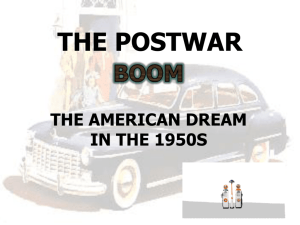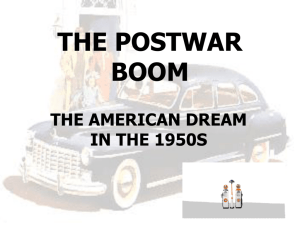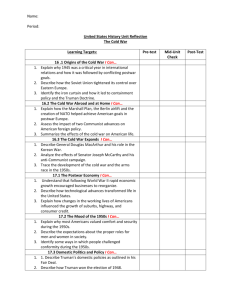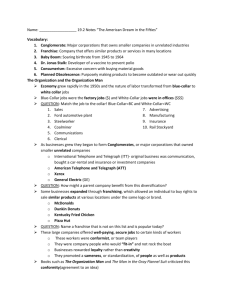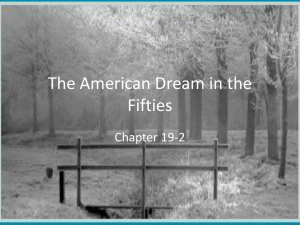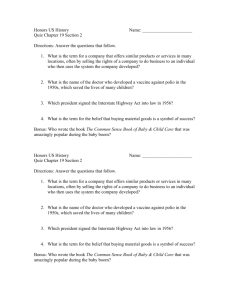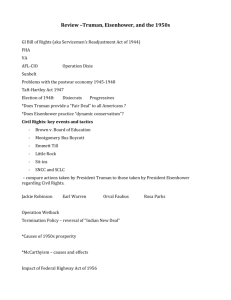the postwar boom - Charleston School District
advertisement
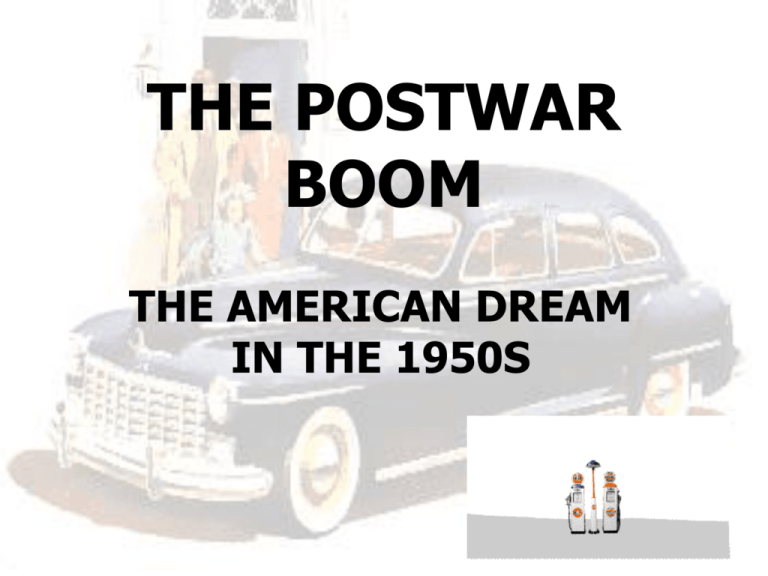
THE POSTWAR BOOM THE AMERICAN DREAM IN THE 1950S #1:Suburbs are born After WWII, returning vets faced a severe housing shortage In response to the crisis, developers used assembly-line methods to mass-produce houses Developer William Levitt bragged that his company could build a home in 16 minutes for $7,000 Suburbs were born With the help of the GI Bill, many veterans moved into suburbs #2:REDEFINING THE FAMILY 50's life A return to traditional roles after the war was the norm Men were expected to work, while women were expected to stay home and care for the children Conflict emerged as many women wanted to stay in the workforce Divorce rates surged #3: REMARKABLE ECONOMIC RECOVERY Experts who predicted a postwar depression were proved wrong as they failed to consider the $135 billion in savings Americans had accumulated from defense work, service pay, and investments in war bonds Americans were ready to buy consumer goods #4:SOCIAL UNREST PERSISTS African Americans felt they deserved equal rights, especially after hundreds of thousands served in WWII Truman took action in 1948 by desegregating the armed forces Additionally, Truman ordered an end to discrimination in the hiring of governmental employees THE 1948 ELECTION Dewey The Democrats nominated President Truman in 1948 The Republicans nominated New York Governor Thomas Dewey Polls showed Dewey held a comfortable lead going into election day TRUMAN WINS IN A STUNNING UPSET Truman holds a now infamous Chicago Tribune announcing (incorrectly) Dewey’s victory Truman’s “Give ‘em hell, Harry” campaign worked Truman won a very close race against Dewey To protest Truman’s emphasis on Civil Rights, the South opted to run a third candidate, South Carolina Governor Strum Thurmond REPUBLICANS PLAN FOR 1952 ELECTION By 1951 Truman’s approval rating sank to an all-time low of just 23% Why? Korean War, rising tide of McCarthyism, and a general impression of ineffectiveness The Republican (right) were chomping at the bit in the ’52 election STEVENSON VS. IKE 1952 ELECTION Stevenson Ike The Democrats nominated intellectual Illinois Governor Adlai Stevenson while the Republicans nominated war hero Dwight David Eisenhower “I LIKE IKE” Eisenhower used the slogan, “I Like Ike” for his presidential campaign Republicans used Ike’s strong military background to emphasize his ability to combat Communism worldwide Checkers IKE’S VP SLIP-UP Nixon and his dog Checkers One potential disaster for Ike was his running mate’s alleged “slush fund” Richard Nixon responded by going on T.V. and delivering an emotional speech denying charges but admitting to accepting one gift for his children – a dog named Checkers The “Checkers speech” saved the ticket IKE WINS 1952 ELECTION Ike Wins Again in ‘56 THE AMERICAN DREAM IN THE FIFTIES After WWII ended, Americans turned their attention to their families and jobs New businesses and technology created opportunities for many By the end of the 1950s, Americans were enjoying the highest standard of living in the world Ozzie and Harriet reflected the perfect American family #5:SOCIAL CONFORMITY American workers found themselves becoming standardized Called the “Organization Man,” the modern worker struggled with a loss of individualism Businesses did not want creative thinkers, rebels or anyone who would “rock the boat” #6:CONGLOMERATES EMERGE Conglomerates, major corporations that include a number of smaller companies in unrelated fields, emerged in the 1950s One conglomerate, International Telephone and Telegraph (ITT), bought rental car companies and hotel chains FRANCHISES EMERGE Another strategy for business expansion was franchising A franchise is a company that offers similar services in many locations Fast food restaurants developed the first franchises in America McDonald’s is one of the leading franchises in the world #7:WHITE FLIGHT In the 1950s, millions of middle-class white Americans left the cities for the suburbs At the same time millions of African American rural poor migrated to the cities The so-called “White Flight” drained cities of valuable resources, money and taxes suburbs THE SUBURBAN LIFESTYLE The American Dream complete with a white picket fence Most Americans worked in cities, but fewer and fewer of them lived there New highways and the affordability of cars and gasoline made commuting possible Of the 13 million homes built in the 1950s, 85% were built in suburbs For many, the suburbs were the American Dream #8:THE BABY BOOM During the late 1940s and through the early 1960s the birthrate in the U.S. soared At its height in 1957, a baby was born in America every 7 seconds (over 4.3 million babies in ’57 alone) Baby boomers represent the largest generation in the nation’s history Johnny Maddie What are the official years of the Baby Boom Generation? 1946 - 1964 saw a marked increase in the number of births in North America. How did the birthrate rise and fall during the baby boom years in the US? 1940 2,559,000 births per year 1946 3,311,000 births per year 1955 4,097,000 births per year 1957 4,300,000 births per year 1964 4,027,000 births per year 1974 3,160,000 births per year WHY SO MANY BABIES? Why did the baby boom occur when it did? Husbands returning from war Decreasing marriage age Desirability of large families Confidence in economy Advances in medicine WHAT IT WILL MEAN TO YOU? Your generation will be supporting an increasingly aging American population #9:ADVANCES IN MEDICINE AND CHILDCARE Advances in the treatment of childhood diseases included drugs to combat typhoid fever and polio (Jonas Salk) Dr. Salk was instrumental in the eradication of polio DR. SPOCK ADVISES PARENTS Dr. Spock’s book sold 10 million copies in the 1950s Many parents raised their children according to the guidelines of pediatrician Dr. Benjamin Spock He thought children should be allowed to express themselves and parents should never physically punish their kids IMPACT OF BABY BOOM As a result of the baby boom 10 million students entered elementary schools in the 1950s California built a new school every 7 days in the late ’50s Toy sales reached an all-time high in 1958 when $1.25 billion in toys were sold Fads of the Baby Boomers Hula Hoops Frozen Foods Poodle Skirts and Saddle Shoes What celebrity deaths have most affected the Baby Boomers? Panty Raids John F. Kennedy Barbie and GI Joe Dolls Bikinis Marilyn Monroe Frisbees Martin Luther King Yo-yos John Lennon Ouija Boards Dune Buggies WOMEN’S ROLES IN THE 1950S During the 1950s, the role of homemaker and mother was glorified in popular magazines, movies, and television WOMEN AT WORK Those women who did work were finding job opportunities limited to fields such as nursing, teaching, and office support Women earned far less than men for comparable jobs #10:LEISURE IN THE 1950s Americans experienced shorter work weeks and more vacation time than ever before Leisure time activities became a multi-billion dollar industry Labor-saving devices added more spare time Labor-saving devices provided more leisure time for Americans POPULAR LEISURE ACTIVITES Bowling remains one of the top leisure activities in the U.S. In 1953 alone Americans spent $30 billion on leisure Popular activities included fishing, bowling, hunting, and golf Americans attended, or watched on T.V., football, baseball, and basketball games #11:THE AUTOMOBILE CULTURE After the rationing of WWII, inexpensive and plentiful fuel and easy credit led many to buy cars By 1960, over 60 million Americans owned autos INTERSTATE HIGHWAY ACT 1956 In 1956 Ike authorized a nationwide highway network – 41,000 miles of road linking America THE INTERSTATE HIGHWAY SYSTEM “Automania” spurred the construction of roads linking major cities while connecting schools, shopping centers and workplaces to residential suburbs IMPACT OF THE HIGHWAY Trucking is the #1 means of moving cargo in the United States today The Interstate Highway system resulted in: More trucking Less railroad More suburbs, further away DOWNSIDE TO MOBILITY While the car industry boom stimulated production, jobs, shopping centers, and the restaurant industry, it also had negative effects: Noise Pollution Accidents Traffic Jams Stress Decline of public transportation #12 RISE OF CONSUMERISM By the mid-1950s, nearly 60% of Americans were members of the middle class Consumerism (buying material goods) came to be equated with success and status NEW PRODUCTS One new product after another appeared in the marketplace Appliances, electronics, and other household goods were especially popular The first credit card (Diner’s Club) appeared in 1950 and American Express was introduced in 1958 Personal debt increased nearly 3x in the 1950s POPULAR CULTURE A new era of mass media led by television emerged in the 1950s In 1948, only 9% of homes had T.V In 1950, 55% of homes had T.V. By 1960, 90% of American homes had T.V. 13:THE GOLDEN AGE OF TELEVISION The 1950s was known as the “Golden Age of Television” Comedies were the main attraction as Milton Berle, Lucille Ball and Desi Arnaz were very popular beaver Lucy link Desi Arnaz and Lucille Ball starred in I Love Lucy TELEVISION EXPERIMENTS WITH VARIOUS FORMATS Television innovations like on-the-scenenews reporting, interviews, westerns and sporting events offered the viewer a variety of shows Kids’ shows like The Howdy Doody Show and The Mickey Mouse Club were extremely popular TV ADS, TV GUIDES AND TV DINNERS EXPAND TV advertising soared from $170 million in 1950 to nearly $2 billion in 1960 TV Guide magazine quickly became the best selling magazine Frozen TV dinners were introduced in 1954 – these complete ready-to-heat meals on disposable aluminum trays made it easy for people to eat without missing their favorite shows A SUBCULTURE EMERGES Although mass media and television were wildly popular in the 1950s, dissenting voices emerged The “Beat Movement” in literature and rock n’ roll clashed with tidy suburban views of life BEATNIKS FOLLOW OWN PATH Beatniks often performed poetry or music in coffeehouses or bars Centered in San Francisco, L.A. and New York’s Greenwich Village, the Beat Movement expressed social nonconformity Followers, called “beatniks”, tended to shun work and sought understanding through Zen Buddhism, music, and sometimes drugs 14:MUSIC IN THE 1950s Musicians in the 1950s added electronic instruments to traditional blues music, creating rhythm and blues Cleveland DJ Alan Freed was the first to play this music in 1951– he called it “rock and roll” FREED ROCK N’ ROLL In the early and mid-fifties, Richard Penniman, Chuck Berry, Bill Haley and the Comets, and especially Elvis Presley brought rock and roll to the forefront The driving rhythm and lyrics featuring love, cars, and problems of being young --captivated teenagers across the country THE KING OF ROCK AND ROLL Presley’s rebellious style captured young audiences Girls screamed and fainted, and boys tried to imitate him THE OTHER AMERICA In 1962, nearly one out of every four Americans was living below the poverty level Most of these poor were the elderly, single women and their children, and/or minorities 1950’s Women Fashions 1950’s Men’s Fashions Telephone Cramming 1950’s Fads Beatniks ’57 Chevy 3D Movies Hula Hoops Disneyland 1950’s Slang Ankle-biter: A child Burn rubber: To accelerate hard and fast (hot-rodders) Cat: A hip person (Beats) Tank: A large sedan (usually Dig: To understand; to approve driven by parents) Earthbound: Reliable Flick: A movie Unreal: Exceptional Greaser: A guy with tons of grease in his hair, Wazoo: Your rear end which later came to describe an entire group of people. Yes, John Travolta in Grease. Heat: Police (Beats) In orbit: In the know Jacketed: Going steady Knuckle sandwich: A fist in the face Like crazy; like wow: Really good, better than cool Make out: A kissing session Nuggets: Loose change Odd ball: Someone a bit off the norm Pad: Home Royal shaft: Badly or unfairly treated Split: Leave

